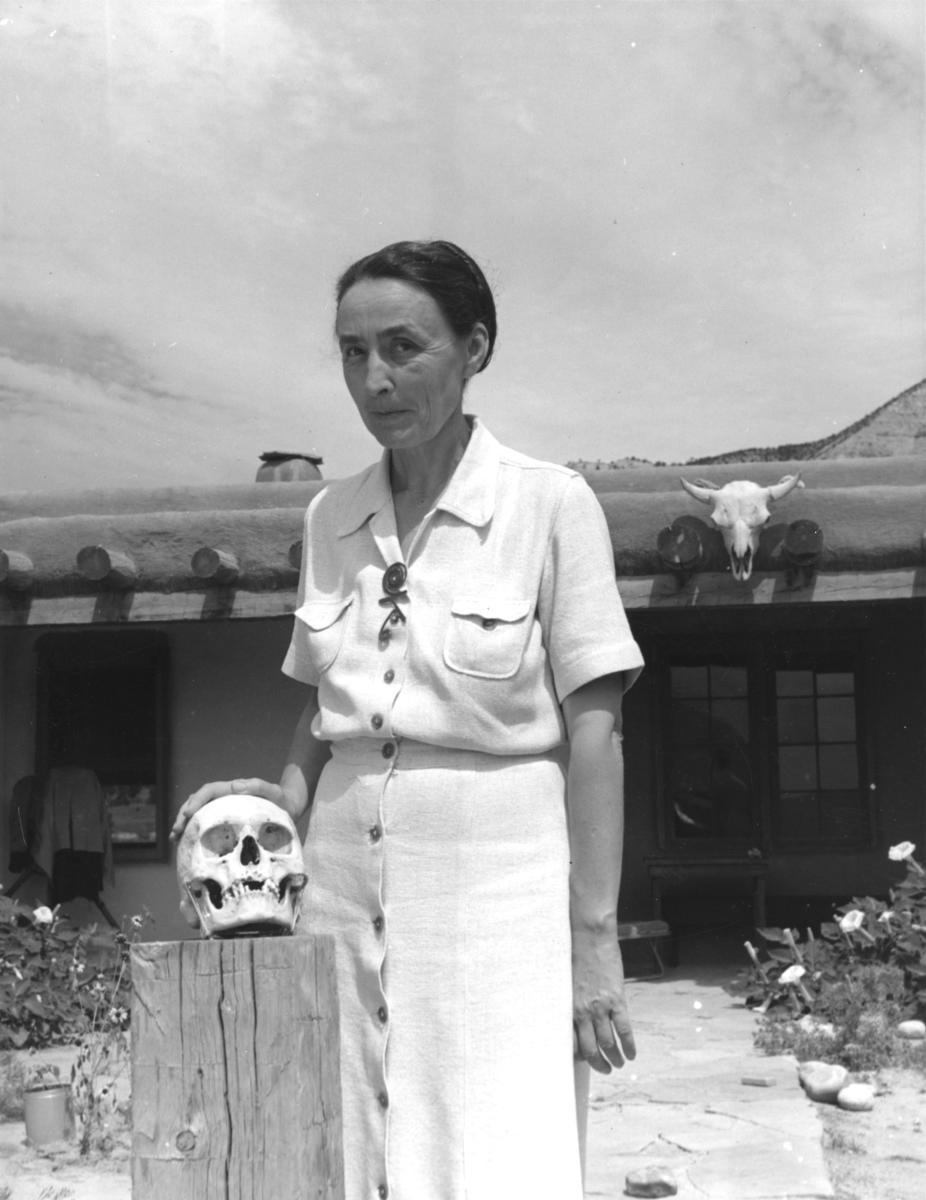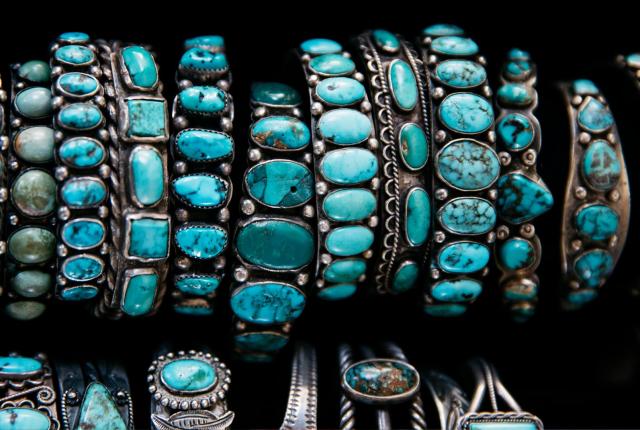A gleaming selection of turquoise bracelets. Courtesy of New Mexico Tourism Department.
True Blue
Back to Top of ListTrue Blue
WATER HELPS COPPER AND ALUMINUM SEEP THROUGH rocks and alchemize into veins of blue stone found in mountains throughout the Southwest. Some cultures revere it as a sky stone, but among New Mexico Pueblo people, it represents the water that helped create it—“and everything that water means in the Southwest: food, abundance, survival,” says Maxine McBrinn, an anthropologist who curated Turquoise, Water, Sky, a 2014 exhibit at the Museum of Indian Arts and Culture, in Santa Fe.
“That title encompasses what I find most meaningful about turquoise,” she says, “the connection between this beautiful stone and the source of life in our region.”
Depending on which mine it’s pulled from, as well as how deep within the mine it occurs, New Mexico’s official state gem can range from deep blue to sky blue to a variety of greens. The veins that often appear within it were once shunned by jewelry makers, but those stones have come to be sought out as customers clamor for them.
“Jewelry collectors love turquoise, and they love high-end turquoise,” says Michael Roanhorse, a Diné artist who caters to the gold-and-diamonds set. “Lander blue is the new favorite. It has the matrix in it, and no one wanted it. My dad said, ‘If I’d known it was going to get so expensive, I could have bought buckets of it when it came out.’ ”
Today, a Lander blue stone can command $200 a carat, and that wee stone weighs about a fifth of a gram.
“In Navajo history, turquoise is used as a representation of the Yeibichai and the Holy People,” Roanhorse says. “Turquoise represents the old way, the Navajo way. You see an old grandpa, he’s always wearing his turquoise.”
The Classics
Back to Top of List From ancient petroglyphs to contemporary pottery, artists continue to make their mark. Photograph by Minesh Bacrania (left) and Virgil Ortiz (right).
From ancient petroglyphs to contemporary pottery, artists continue to make their mark. Photograph by Minesh Bacrania (left) and Virgil Ortiz (right).
The Classics
For centuries, New Mexico artists have perfected their craft in a variety of mediums. Here are a few.
Rock art
Ancient tribespeople left images of their beliefs pecked into basaltic rocks (petroglyphs) or painted onto cliffsides (pictographs). Head to Three Rivers Petroglyph Site, near Tularosa, Petroglyph National Monument, in Albuquerque, and the Gila Cliff Dwellings National Monument, near Silver City.
Pottery
From the Ancestral Puebloans forward, fantastically decorated clay serves as a trademark of identity—intricately lined Mimbres pottery and black-on-black San Ildefonso pots. Contemporary potters like Cochiti’s Virgil Ortiz embed their works with political statements and humorous motifs.
Painting
In the late 19th century, New Mexico boomed with art colonies that continue to inspire new generations. Commune with historical and contemporary works at the Harwood Museum of Art, in Taos, the New Mexico Museum of Art, in Santa Fe, and the Indian Pueblo Cultural Center, in Albuquerque.
Jewelry
Navajos became masters of silverwork. Zuni and Santo Domingo pueblos stand out for their stonework. Meet makers of many tribes at the annual Santa Fe Indian Market each August and at trading posts and galleries throughout the state.
Santos
Spanish colonists used the materials at hand to create religious art, carving bultos (statues) from cottonwood roots and retablos (paintings) with local pigments. See them at the Museum of Spanish Colonial Art, in Santa Fe, and Casa San Ysidro, in Albuquerque.
Weaving
Navajo and Hispanic weavers turn sheep’s wool into stories of beauty and place. Collectors gather at the Crownpoint Navajo Rug Auction to bid on pieces. In Chimayó, Spanish traditions prevail at Centinela Traditional Arts and Ortega’s Weaving Shop.
The Best: Georgia O'Keeffe
Back to Top of List Georgia O'Keeffe with skull, Ghost Ranch, New Mexico. 1939. Photography by John Candelario. Courtesy of the Palace of the Governors Photo Archives (NMHM/DCA) 165653.
Georgia O'Keeffe with skull, Ghost Ranch, New Mexico. 1939. Photography by John Candelario. Courtesy of the Palace of the Governors Photo Archives (NMHM/DCA) 165653.
The Best: Georgia O’Keeffe
Georgia O’Keeffe settled in Abiquiú and grew into an icon, not only for her modernist interpretations of flowers and landscapes but for her fierce autonomy. Eleven years after her 1986 death, the Georgia O’Keeffe Museum opened in Santa Fe, with stunning samples of her work. “There has been a growing fascination with O’Keeffe the person,” says curator Ariel Plotek. “The dual sides of her story—the life and the art—have come to interest our audience more and more.”
O’Keeffe carefully crafted her own image, working with handpicked photographers (including her husband, Alfred Stieglitz) and maintaining a minimalist’s flair in her clothing and home decor. Even as waves of consumerism postdated her, that commitment to austerity has won admirers.
“There’s a trailblazing quality to her story that spoke directly to one generation,” Plotek says, “and now there is a younger generation of mainly young women who are able to identify with O’Keeffe as a sort of prototypical badass. Her choices and independence still resonate.”
The Worst: Fake Native American Jewelry
Back to Top of List Always buy jewelry directly from artists or reputable dealers. Illustration by Chris Philpot.
Always buy jewelry directly from artists or reputable dealers. Illustration by Chris Philpot.
The Worst: Fake Native American Jewelry
Fake Native American jewelry. Mass-produced, often in overseas factories, it features cheap components so cleverly fabricated that even experts can be stumped. It robs legitimate artists of sales and drives down the prices they can ask for the real thing. Always buy directly from artists or reputable dealers.


